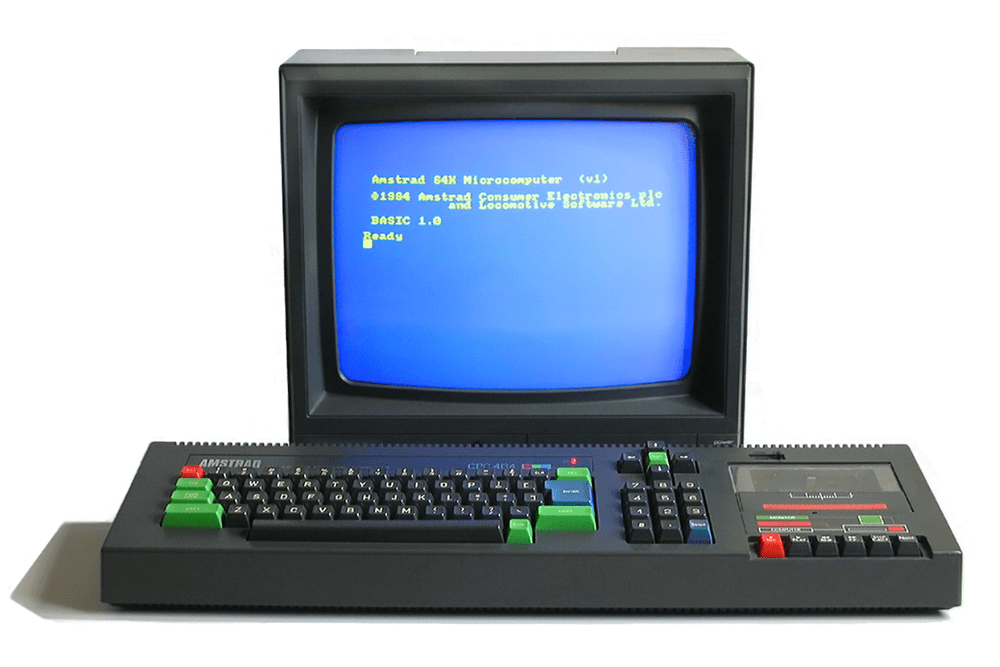At Antstream we all have an emotional connection to the games we source and provide. We also have our favorite systems and often debate which was ‘the best’ of their respective eras. These fun and affectionate competitive discussions are all rooted in our experiences of gaming through our childhood and beyond.
My first computer was an Amstrad 464+. My father bought it for me around Christmas time of 1991. I was amazed by the games (Turrican II was the first computer game I ever played) and I even tried to understand the BASIC programming language as described in the manual. If you are an Amstrad fan, no doubt that you will have a similar experience. If so, make sure to share them in our Discord channel, we will display some of the best Amstrad memories on our social media channels.
Amstrad’s Impact on Computing
When looking at the history of computer gaming, one British company stands out for its remarkable journey from consumer electronics to pioneering the affordable home computer market – Amstrad. Founded in 1988 by Sir Alan Sugar, Amstrad quickly made a name for itself in the realm of consumer electronics and audio equipment. However, it was in the 1980s and 1990s that Amstrad truly left its mark on the technology landscape, with a series of innovative and budget-friendly home computers.
Amstrad’s Early Foray into Computing
The 1980s marked a pivotal moment for Amstrad as it ventured into the world of home computing. At the heart of this endeavor was the Amstrad CPC series, which made its debut in 1984. These computers, including the CPC 464, 664, and 6128 quickly gained popularity for one key reason, affordability. At a time when personal computers were often seen as expensive and out of reach for the average household, Amstrad’s CPC series sought to change that narrative.
Another aspect that set the Amstrad series of computers apart was the thoughtfully bundled peripherals. Each computer came with its own color monitor, eliminating the need for consumers to purchase separate components and driving down the cost of entry. This strategy proved to be a game-changer, as it made computing accessible to a wider audience.
The Amstrad CPC computers were powered by the Z80 processor and featured a range of software, making them versatile for both gaming and productivity. While they may not have competed directly with some of the more powerful gaming machines that began to appear in the last 80’s, they found a dedicated user base and a place in the hearts of many.
The PCW Series
It wasn’t just personal computers that captured the company’s attention in the 1980s. In 1985, Amstrad unveiled the PCW (Personal Computer Word Processor) series, a departure from traditional personal computers that targeted a niche yet growing market. The PCW series was a response to the increasing demand for dedicated word-processing machines, particularly in businesses and offices. At the time, word processing represented a significant technological shift from typewriters to electronic document creation. Amstrad recognized this trend and sought to address it with a cost-effective and user-friendly solution.
What made the PCW series stand out was its integration of word-processing software and accompanying hardware. Each PCW computer came bundled with Amstrad’s own word-processing software, which was easy to use and designed for efficiency. Alongside the software, PCW computers were equipped with dot matrix printers, allowing users to print their documents conveniently. This integrated approach reduced the complexity of setting up a word processing system and contributed to the series’ appeal.
The PCW computers featured monochrome monitors and were known for their reliability. They struck a balance between functionality and affordability, making them an attractive choice for small businesses, professionals, and individuals who needed word processing capabilities without the complexity of a full-fledged personal computer.
One of the standout models in the PCW range was the PCW8256, which featured 256 kilobytes of memory and a 3-inch built-in floppy disk. This model found its niche in the market and established Amstrad as a reliable provider of word-processing solutions.
Although the PCW series eventually gave way to the evolution of personal computing, it left an indelible mark on the trajectory of Amstrad’s technological journey, foreshadowing the company’s enduring impact on affordable technology.
Amstrad’s Transition to PC-Compatible Computers:
By the mid-1980s, Amstrad had firmly established itself as a player in the home computer and word processing markets, with its Amstrad CPC and PCW series garnering attention and a dedicated user base. However, the ever-evolving technology landscape prompted Amstrad to explore new horizons. One of the pivotal moments in the company’s history was its entry into the PC-compatible computer market.
In 1986, Amstrad introduced the Amstrad PC1512, marking its foray into the world of IBM PC-compatible computers. The PC1512 was a significant departure from Amstrad’s earlier offerings, as it embraced the IBM PC standard, making it compatible with a wide range of software and peripherals. This move was strategic, as it allowed Amstrad to tap into a market dominated by more established players.
What set the PC1512 apart from competitors was its affordability. Amstrad’s reputation for providing cost-effective technology solutions was reflected in this new venture. The PC1512 was priced competitively, making it an attractive option for both individual users and businesses. It was available in various configurations, offering a choice of monochrome or color displays and hard drive options, further catering to diverse needs.
One of the key selling points of the PC1512 was its ease of use. Amstrad designed it with a focus on user-friendliness, making it accessible to those who might be new to personal computing. This approach resonated with consumers, and the PC1512 quickly gained popularity.
Building on the success of the PC1512, Amstrad continued to refine its PC-compatible offerings. In 1987, the company introduced the PC1640, an upgraded version of the PC1512. The PC1640 boasted improved graphics capabilities and expanded memory options, further enhancing its appeal to both home users and small businesses.
Amstrad’s venture into the PC-compatible market was not without challenges, as it faced competition from established giants like IBM and Compaq. However, the company’s commitment to affordability and user-friendly design allowed it to carve out a niche and make a mark in the industry.
This transition marked a significant evolution for Amstrad, as it moved from manufacturing proprietary systems to embracing open standards. It demonstrated the company’s adaptability and willingness to meet the changing demands of the technology landscape.
The success of the PC-compatible computers laid the foundation for Amstrad’s continued growth and influence in the personal computing world. It was a testament to the company’s ability to pivot and innovate while staying true to its core principles of accessibility and affordability.
Competing in the IBM PC Clone Market:
As Amstrad made its bold foray into the world of PC-compatible computers, it found itself in a fiercely competitive landscape, going head-to-head with industry giants such as IBM, Compaq, and other notable PC manufacturers. This marked a pivotal moment in the company’s history as it sought to make a name for itself in the burgeoning IBM PC clone market in Europe.
At the heart of Amstrad’s strategy was its commitment to affordability and accessibility, qualities that had already become synonymous with the Amstrad brand. The Amstrad PC1512 and its subsequent iterations entered the market at price points that significantly undercut many of its competitors. This affordability was a game-changer, especially for cost-conscious consumers and small businesses looking to leverage the power of personal computing.
One of the critical aspects that set Amstrad apart in this competitive arena was its attention to bundling. Each PC1512 package not only included the computer but also essential peripherals like a monitor, keyboard, and mouse. This approach eliminated the need for consumers to assemble a piecemeal computing setup and simplified the entire purchasing process. It was a compelling proposition for those looking for an all-in-one solution.
Amstrad’s decision to offer various configurations of the PC1512 further broadened its appeal. Users could choose between monochrome or color displays, depending on their needs. This flexibility allowed Amstrad to cater to a diverse user base, ranging from home users seeking entertainment to small businesses in need of office productivity tools.
In addition to affordability and bundled convenience, Amstrad placed a strong emphasis on user-friendliness. The company’s commitment to making personal computing accessible to a broader audience was evident in the design of its PC-compatible computers. The intuitive user interface and straightforward setup procedures made the PC1512 an attractive option, particularly for those who were new to computing.
Amstrad’s success in the IBM PC clone market demonstrated its ability to not only compete but thrive in a competitive environment. It underscored the company’s commitment to its founding principles of providing cost-effective, user-friendly technology solutions. As a result, Amstrad became a prominent player in the European personal computer landscape.
Challenges and Shifting Focus:
The late 1980s and early 1990s marked a period of significant change and challenge for Amstrad. While the company had made a name for itself in the home computer and PC-compatible markets, the technology landscape was rapidly evolving, presenting new hurdles and opportunities.
One of the primary challenges Amstrad faced was the ever-increasing competition from more established PC manufacturers. As the personal computer market matured, major players like IBM, Compaq, and others continued to innovate and dominate the industry. Their deep pockets and extensive resources allowed them to stay at the forefront of technological advancements.
Moreover, the shift from 8-bit to 16-bit computing was well underway, with more advanced systems hitting the market. This transition posed a dilemma for Amstrad, which had built its reputation on affordable and accessible computing. Adapting to the changing landscape while maintaining its core principles was a daunting task.
In response to these challenges, Amstrad made strategic decisions to pivot its focus. The company diversified its interests, exploring opportunities in telecommunications and satellite television equipment. This move was in line with Amstrad’s historical pattern of identifying emerging markets and adapting to them. The company’s telecommunications ventures included products like cordless phones and answering machines, while its satellite TV equipment contributed to the burgeoning satellite television industry.
The shift in focus allowed Amstrad to leverage its expertise in consumer electronics and manufacturing capabilities to enter new markets. While the company continued to support and sell its existing computer products, it was clear that Amstrad was moving away from the personal computing sphere that had defined its earlier years.
This strategic shift did not diminish the impact Amstrad had made in the world of technology. Instead, it reflected the company’s adaptability and willingness to explore new frontiers. Amstrad’s legacy as a pioneer of affordable technology remained intact, even as it diversified its portfolio.
As the 1990s progressed, Amstrad continued to thrive in its new ventures, demonstrating that its success was not limited to one industry. The company’s ability to recognize market trends and adapt to changing consumer demands remained one of its defining characteristics.
Legacy of Amstrad Computers:
Amstrad’s journey through the world of consumer electronics and personal computing left a powerful mark on the technology landscape, particularly in Europe. While the company’s prominence in the personal computer market waned in the face of fierce competition and changing industry dynamics, the legacy of Amstrad computers endures as a testament to its pioneering spirit and innovation.
One of the most remarkable aspects of Amstrad’s legacy is its commitment to affordability. The Amstrad CPC and PC-compatible computers challenged the prevailing notion that computing was a luxury accessible only to a select few. Instead, Amstrad made technology attainable for a broader audience. Families, small businesses, and individuals who might have otherwise been excluded from the digital revolution found their entry point through Amstrad computers.
Amstrad’s approach to bundling, offering all-in-one packages that included not just the computer but also essential peripherals, was groundbreaking. This strategy simplified the purchasing process and eliminated the need for consumers to navigate the complexities of assembling a computing setup. It was a model that resonated with many and left a lasting impact on the way personal computers were marketed.
Furthermore, Amstrad’s legacy extends to its user-friendly design philosophy. The company understood that technology should be approachable, and its computers reflected this principle. The intuitive interfaces and straightforward setup procedures made Amstrad machines particularly appealing to those who were new to computing. This emphasis on usability paved the way for more inclusive technology adoption.
Although Amstrad’s foothold in the personal computer market eventually shifted, the influence of its computers remained palpable. Many individuals fondly remember their Amstrad CPC or PCW machines as their first introduction to computing. These early experiences fostered a generation of enthusiasts and professionals who would go on to shape the technology landscape.
Amstrad’s legacy also extends to its adaptability and willingness to explore new frontiers. The company’s successful foray into telecommunications and satellite television equipment demonstrated its capacity to recognize market trends and evolve with changing consumer demands.
Amstrad’s journey serves as a reminder that innovation and accessibility are not mutually exclusive. While the company’s name may not be as frequently heard in today’s technology conversations, its legacy endures as a testament to its commitment to democratizing technology and making it accessible to all.
Amstrad’s computers were not just machines; they were gateways that ushered in a new era of technology accessibility. The legacy of Amstrad computers remains a poignant reminder that the spirit of innovation and inclusivity can leave a lasting impact that extends far beyond the life of a product.
The Amstrad CPC 464 Series: Pioneering Affordable Computing in the 1980’s
In the early 1980s, the personal computer revolution was well underway, but owning a computer remained a luxury out of reach for many. However, this landscape changed dramatically with the introduction of the Amstrad CPC 464, a groundbreaking computer that not only made computing affordable but also set a new standard for accessibility. Let’s delve into the legacy of the Amstrad CPC 464 and its role in revolutionizing home computing.
The Birth of the CPC 464:
In 1984, Amstrad, a British consumer electronics company founded by Sir Alan Sugar, unveiled a machine that would capture the imagination of millions—the Amstrad CPC 464. The “464” in its name signified the computer’s 64 KB of RAM, a standard for personal computers of the time.
Specifications and Versatility:
Under the hood, the CPC 464 was powered by an 8-bit Zilog Z80 CPU running at 4 MHz. It featured a distinctive, built-in cassette deck for loading software, which was a common method of software distribution at the time. Additionally, it had three channels of sound, which made it capable of producing enjoyable audio experiences, whether in games or creative applications.
The CPC 464’s versatility was another of its strengths. It could handle a wide range of tasks, from gaming and word processing to programming and educational software. This versatility made it appealing to a diverse audience, from students to families and small businesses.
Legacy and Enduring Impact:
The Amstrad CPC 464’s legacy endures as a testament to Amstrad’s commitment to affordability and accessibility in technology. It opened the doors of computing to countless individuals and played a pivotal role in the democratization of technology during the 1980s.
While the CPC 464 may have been succeeded by more advanced computers, it remains a beloved piece of computing history. For those fortunate enough to have experienced it, the CPC 464 represents not just a machine but a cherished memory of the early days of personal computing. It was a symbol of innovation, affordability, and the belief that technology should be for everyone.
Conclusion:
The Amstrad CPC 464 was more than just a computer; it was a game-changer. It exemplified the idea that technology should be accessible to all, regardless of budget or experience. The CPC 464’s impact on the world of personal computing is undeniable, and it will forever hold a special place in the hearts of those who grew up with it, as a reminder of an era when the digital age became within reach of the masses.
Standout Games on the Amstrad 464
Here’s a list of some of the best games on the 464 according to our AntTeam. Agree or disagree? Let us know on our Discord Channel.
Chuckie Egg (1983):
“Chuckie Egg” is an iconic platform game that became synonymous with the CPC 464. In this classic, you control Hen-House Harry as he dashes around a series of platforms, collecting eggs while avoiding enemies. The gameplay’s simplicity and addictive nature made “Chuckie Egg” an enduring favorite among players of all ages.
Jet Set Willy (1984):
Another iconic platformer, “Jet Set Willy” follows the adventures of Willy as he explores his sprawling mansion, collecting items while avoiding bizarre obstacles and creatures. The game’s surreal and challenging level design, combined with its catchy music, ensured its place in gaming history.
Dizzy Series (1987-1993):
The “Dizzy” series introduced players to the lovable egg-shaped adventurer, Dizzy, and his whimsical world. These puzzle-platform games, including titles like “Treasure Island Dizzy” and “Fantasy World Dizzy,” offered charming graphics, brain-teasing puzzles, and memorable characters that captivated players for years.
Cauldron (1985):
In “Cauldron,” you control a witch on a broomstick, navigating through challenging levels filled with enemies and obstacles. The game’s eerie atmosphere and tight controls made it a standout title and its unique premise garnered a dedicated fanbase.
Oh Mummy (1984):
A simple yet addictive game, “Oh Mummy” challenges players to explore Egyptian tombs, uncover treasures, and avoid mummies. The game’s fast-paced action and strategic elements kept players coming back for more.
Chase H.Q. (1989):
“Chase H.Q.” brought high-octane action to the CPC 464. As a police officer in a high-speed pursuit, players raced against the clock to catch criminals. The game’s thrilling gameplay and impressive graphics showcased the CPC 464’s capabilities.
Barbarian (1987):
“Barbarian” was known for its impressive graphics and memorable cover art featuring a scantily clad warrior. The game offered one-on-one combat in a brutal arena, and it gained attention for its innovative use of digitized speech.
Boulder Dash (1984):
In “Boulder Dash,” players controlled Rockford, a miner exploring underground caves, collecting gems, and avoiding falling boulders and enemies. The game’s combination of strategy and quick reflexes made it a classic puzzle adventure.
The Amstrad CPC Plus Range: Pushing the Boundaries
of 8-bit Computing
In the late 1980s, the Amstrad CPC range had already earned its place in the annals of computing history as a budget-friendly yet versatile platform. However, Amstrad was not content with resting on its laurels. The company sought to push the boundaries of 8-bit computing further by introducing the Amstrad CPC Plus range. This series of computers, which included the CPC 464 Plus, CPC 6128 Plus, and GX4000 gaming console, represented Amstrad’s commitment to innovation and excellence in the ever-evolving world of technology.
CPC Plus: Enhanced Hardware for Enhanced Experiences:
The Amstrad CPC Plus range, launched in 1990, was more than just a minor upgrade. It featured significant improvements over its predecessors, enhancing both the hardware and the overall user experience. The Plus series was designed to compete with emerging 16-bit systems, delivering enhanced graphics, sound, and capabilities while retaining compatibility with existing CPC software.
Improved Graphics and Color Palette:
One of the standout features of the CPC Plus range was its enhanced graphics capabilities. These computers boasted an expanded color palette, allowing for richer and more vibrant visuals. The addition of hardware sprites improved game graphics and animation, providing a more immersive gaming experience.
Advanced Sound:
Sound was another area where the CPC Plus range excelled. These computers featured a superior sound chip, the General Instrument AY-3-8912, which provided enhanced audio capabilities. The result was richer and more dynamic soundtracks and effects in games and applications.
Backward Compatibility:
Amstrad was keenly aware of its existing user base, and one of the Plus range’s strengths was its backward compatibility with older CPC software. Users could enjoy their favorite classic games and applications while also benefiting from the improved hardware when running newer software designed specifically for the Plus range.
GX4000: The Gaming Console:
As part of the Plus range, Amstrad introduced the GX4000 gaming console. While not a traditional personal computer, the GX4000 used a modified version of the CPC Plus hardware. It was designed to compete with other gaming consoles of the era, featuring a controller and a library of games optimized for the system.
Legacy and Influence:
Although the Plus range did not achieve the same level of success as some of its competitors, it left a lasting legacy in the world of 8-bit computing. These computers demonstrated Amstrad’s commitment to technological advancement and their dedication to providing an excellent user experience.
Today, the CPC Plus range is remembered fondly by retro gaming enthusiasts who appreciate the enhanced graphics and sound capabilities it brought to the CPC platform. It stands as a testament to Amstrad’s ability to adapt to changing technology trends and to continually innovate in the pursuit of excellence.
The post The Legacy of the Amstrad appeared first on Old School Gamer Magazine.










